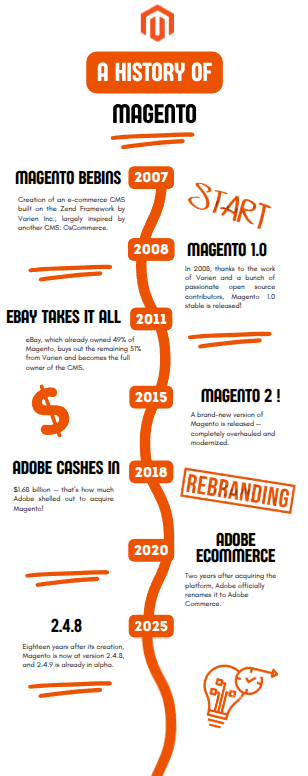Ah, Magento! For most of you reading this, it’s probably a love-hate relationship with our favorite stack. A bit like Rachel and Ross: we get mad at it often, but we’ll still defend it to the bitter end. Today, I want to take a moment to look back at the story of this stack that sometimes drives us crazy… but that we keep using, loving, and improving day after day.
From its birth in 2007 as an internal CMS by Varien Inc., to its acquisition first by eBay and then Adobe, and all the way to version 2.4.9 expected next year — Magento has had quite a journey.
Before Adobe: the foundational years
Back in 2007, Varien Inc. launched a pretty bold project: to create a free, modular e-commerce CMS built for developers. Something strong, based on Zend Framework, taking inspiration from OsCommerce — but with a whole new level of ambition. By 2008, Magento 1.0 was officially released, and the momentum was undeniable.
The stack clicked. Hard. Its modular architecture, nearly endless flexibility, and deeply technical orientation made it a hit among merchants and developers alike. So much so that eBay started paying attention. In 2010, they bought in. By 2011, they owned the whole thing.
But despite the influx of resources, things were rocky. Magento 2 was delayed again and again, the internal atmosphere grew tense, and many core team members eventually moved on. The community grew uneasy. Magento was still big — but its future wasn’t so clear anymore.
Under Adobe: restructuring and rebranding
Then came 2018. A new shift. Adobe bought Magento for $1.68 billion. Big move, clear goal: add Magento to the Adobe Experience Cloud and go full throttle on e-commerce. The Commerce version (formerly Magento Commerce) became the focus, while the Open Source edition — still available — clearly faded from the spotlight.
In 2020, Adobe doubled down on the branding: “Magento” was officially renamed “Adobe Commerce” in all corporate communications. And while most of us still say “Magento 2” out of habit, it’s obvious the Open Source side was slowly being sidelined. Fewer major updates. Less public roadmap. More frustration in the community.
Magento today: still a solid choice
And yet… Magento is still here. Still strong. It remains one of the most powerful e-commerce platforms out there. It runs thousands of live stores, still has committed integrators, and a developer base that hasn’t let go. Because Magento lets you do just about anything. It’s demanding, sure — but that’s part of the appeal.
Version 2.4.7, released in 2024, shows that the core is still alive. But tensions between the community and Adobe persist: lack of vision, lack of transparency, and a clear lack of open source love.
A new chapter ahead?
But there’s something brewing. The Magento Association seems to be waking up. Recently, we’ve seen some movement — the will to take back control of the Open Source direction. Give devs a voice again. Reignite community energy. Build a roadmap that’s independent, focused, transparent. It’s early days, but it might just be the beginning of something new.
Magento has come a long way since 2007. And we might be standing at the edge of a true rebirth. But that — well, that’s a story for another article.

